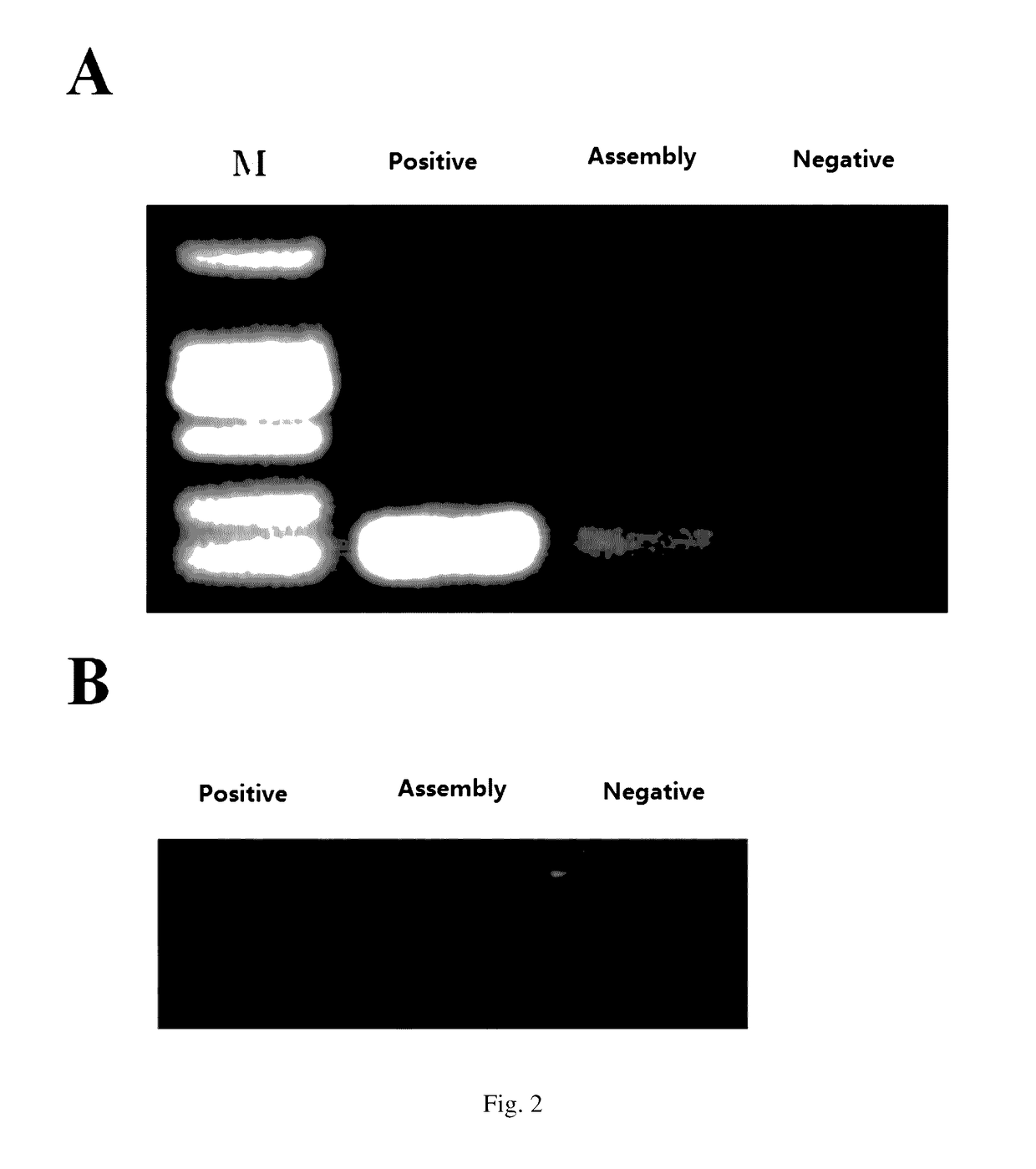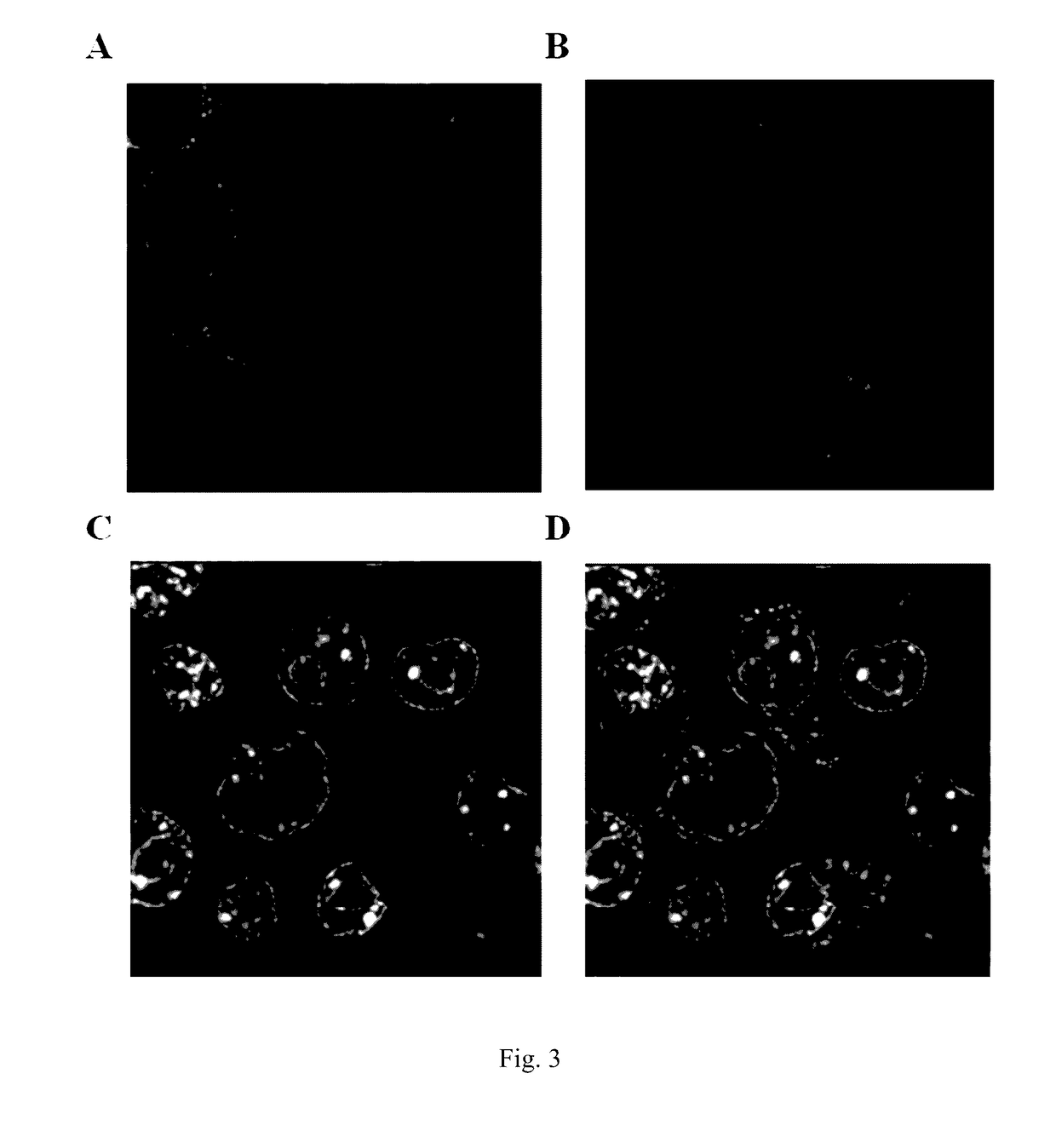Method For Introducing Exogenous Mitochondria Into A Mammalian Cell
a technology of exogenous mitochondria and mammalian cells, applied in the field of biological and genetic engineering, can solve the problems of immature mitochondrial genetic modification technology, no success in achieving mitochondrial genetic modification, and immature mitochondrial genetic modification, etc., and achieve stable gfp expression, stable passage, and simple and effective
- Summary
- Abstract
- Description
- Claims
- Application Information
AI Technical Summary
Benefits of technology
Problems solved by technology
Method used
Image
Examples
example 1
[0048]This embodiment demonstrates that exogenous mitochondria may enter into mammalian cells by endocytosis. The endogenous mitochondria of the macrophages were labeled with EYFP by stably expressing fluorescent protein EYFP localized in mitochondria in macrophages. The endogenous mitochondria of the NIH3T3 cells were labeled with DsRed2 by stably expressing fluorescent protein DsRed2 localized in mitochondria in NIH3T3 cells. The NIH3T3 mitochondria labeled with DsRed2 were isolated and added to a macrophage culture system. Observations were made using a confocal microscope after 12 hours. It was observed that mitochondria labeled with DsRed2 entered macrophages and presented the same morphology as the endogenous mitochondria of the macrophages labeled with EYFP. Specifically:
[0049]1. Mouse macrophage cell line RAW264.7 cells and NIH3T3 cell culture medium (high glucose DMEM (commercially available from Hyclone, Item No: SH30022.01B); 10% fetal bovine serum (commercially available...
example 2
[0058]In this embodiment, a circular mitochondrial DNA of designed sequence, i.e., a circular mitochondrial DNA containing GFP-COX-I fusion gene, is obtained by gene introduction, i.e., insertion, of GFP and Linker sequences, primer synthesis, and DNA splicing, to mouse mitochondrial DNA.
[0059]Designing a New Artificial Circular Mitochondrial DNA:
[0060]In this embodiment, a circular mitochondrial DNA is obtained by gene transfer, i.e., insertion, of GFP and Linker sequences, primer synthesis, and DNA splicing, to mouse mitochondrial DNA. Specifically, the sequence was derived from a known mitochondrial DNA sequences of wild type C57 BL / 6J mice (source of sequence: NCBI GenBank: EF108336) and GFP gene and Linker sequences were inserted in the position 5328 (specifically, as shown in Seq ID No.1), to obtain a designed circular mitochondrial DNA around 5 Kb containing the GFP-COX-I fusion gene.
[0061]2. Depending on the specific composition of the designed circular mitochondrial DNA fro...
example 3
[0066]In this embodiment, the process of producing synthetic mitochondria through in vitro assembly of the circular mitochondrial DNA obtained in Example 2 and empty mitochondrial shells of NIH3T3 Rho0 cells is described, as well as the extraction and identification processes of the RNA and DNA of the synthesized mitochondria. FIG. 2 shows the detection of proper transcript (FIG. 2A) and DNA replicates (FIG. 2B) in the synthetic mitochondria.
[0067]I. Culturing of the Mitochondrion DNA-Free Rho0 Free Cells:
[0068]1. 1.5 μg / mL ditercalinium or 250 ng / mL ethidium bromide, 50 μg / mL uridine (Sigma), and 110 μg / mL sodium pyruvate were added to NIH3T3 cell culture medium;
[0069]2. Incubation was performed continuously for a month according to conventional methods;
[0070]3. NIH3T3 Rho0 medium (high glucose DMEM, 10% fetal bovine serum, 50 μg / mL uridine, 110 μg / mL sodium pyruvate, double antibody of penicillin and streptomycin) was used for culturing;
[0071]4. Cells were collected, i.e., NIH3T3 ...
PUM
 Login to View More
Login to View More Abstract
Description
Claims
Application Information
 Login to View More
Login to View More - R&D
- Intellectual Property
- Life Sciences
- Materials
- Tech Scout
- Unparalleled Data Quality
- Higher Quality Content
- 60% Fewer Hallucinations
Browse by: Latest US Patents, China's latest patents, Technical Efficacy Thesaurus, Application Domain, Technology Topic, Popular Technical Reports.
© 2025 PatSnap. All rights reserved.Legal|Privacy policy|Modern Slavery Act Transparency Statement|Sitemap|About US| Contact US: help@patsnap.com



